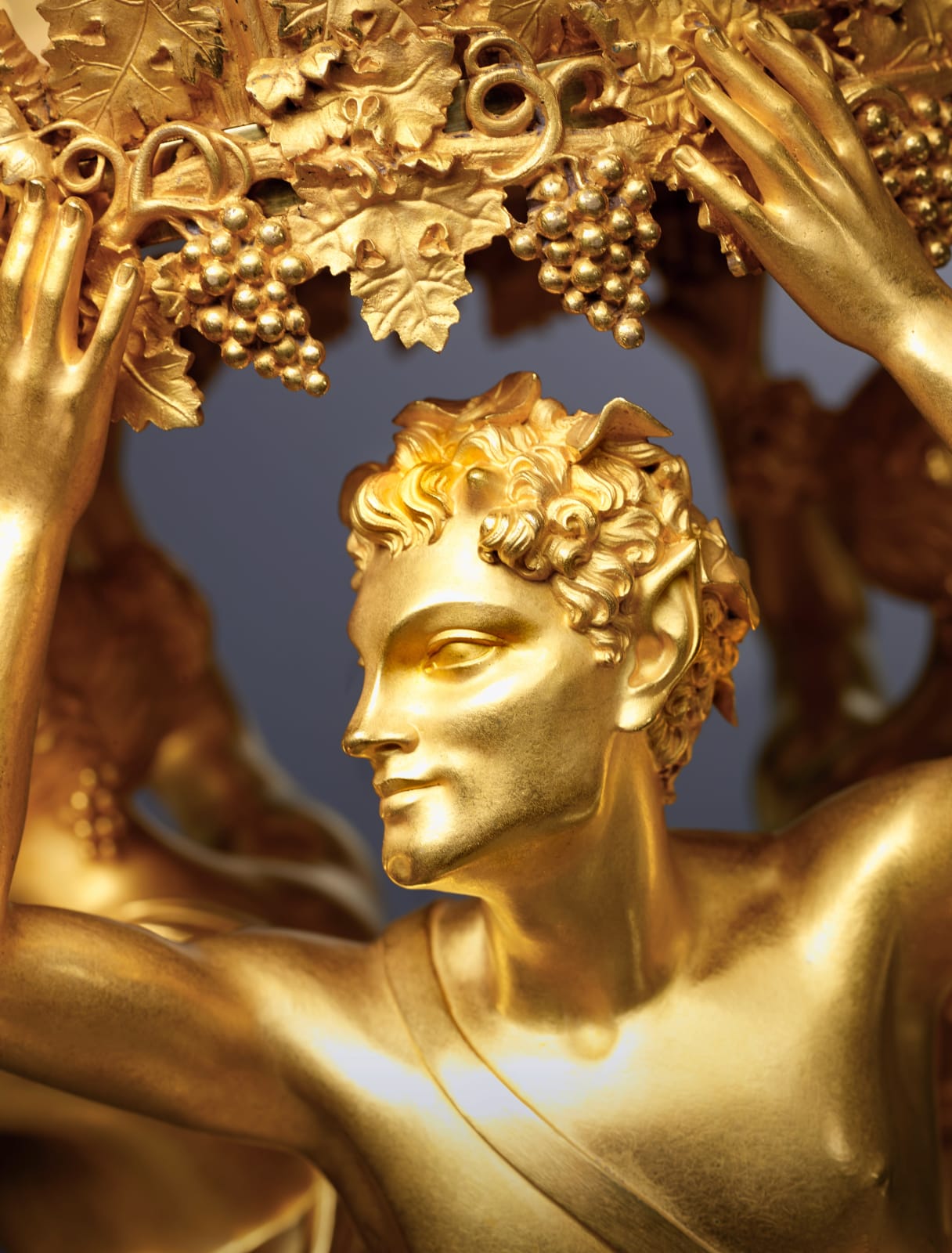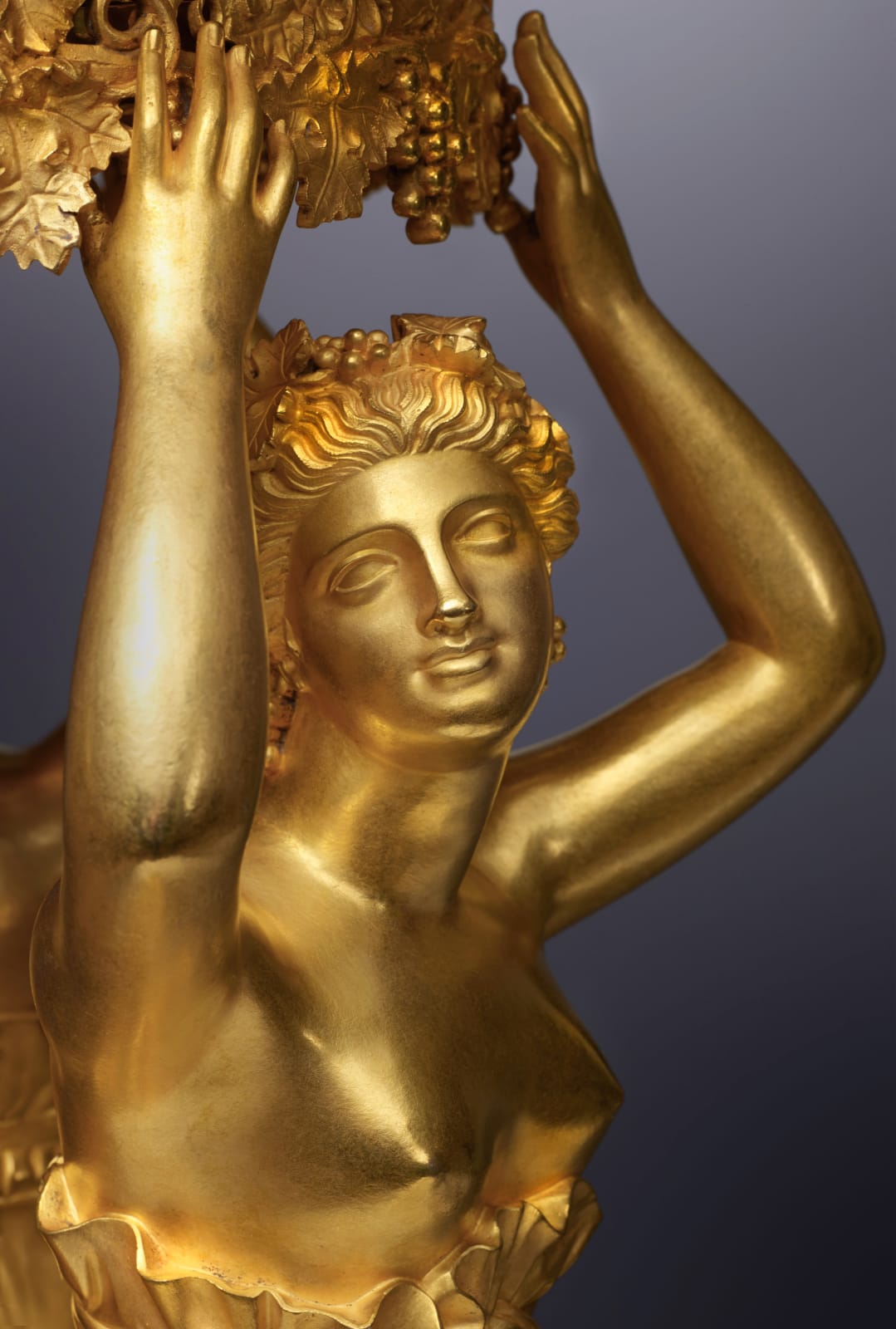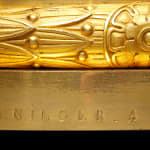Pierre-Philippe Thomire (attributed to) French, 1731-1843
Further images
Literature
Hans Ottomeyer and Peter Pröschel, "Vergoldete Bronzen", 1986, p. 387, pl. 5.16.12, illustrating a comparable gilt bronze centrepiece by Thomire in the Victoria and Albert Museum, London.
A superb and exceptional quality Empire gilt bronze figural centrepiece with a detachable twelve-light candelabra ring attributed to Pierre-Philippe Thomire and stamped on the base J. G. Danninger A Vienne in his capacity as retailer, the elaborate pierced basket abundantly ornamented overall with bunches of grapes and vine trails, with a removable candelabra ring above with twelve scrolled candle branches each terminated by vase-shaped nozzles and circular drip-pans, the basket seemingly held aloft by three Bacchantes wearing vines in their hair and scantily clad classical robes as they dance upon a stepped circular pedestal mounted with a ring of dancing Maenads, on a berried laurel wreath wrapped circular base
Paris, date circa 1810-15
Height 78 cm.
Owing to its exceptional quality as well as its style this magnificent centrepiece was almost certainly made by the preeminent Empire bronzier Pierre-Philippe Thomire (1751-1843). Interestingly it is stamped on the base with the name of Johann Georg Danninger (d. 1848) of Vienna, who supplied many fine bronzes to the Imperial Viennese court. It is very likely that Danninger acquired the centrepiece direct from Thomire and then added his own stamp when retailing the work in Austria. Thomire is known to have made a number of very similar centrepieces including one bearing the great master's stamp that was acquired by this gallery. That piece features an almost identical pierced grape cluster basket which is fitted with a detachable ring of nine, as opposed to twelve, identical scrolled candle branches. As here there are three classical (but not identical) female figures below the basket, standing on a circular pedestal. One can also cite another attributed Thomire centrepiece supported by three identical Bachantes in the Biblioteca Ambrosiana, (shown in London at the Royal Academy exhibition entitled "The Age of Neoclassicism", 1972, no. 1768). In addition, a candelabrum by Thomire of circa 1810 in the Ludwigsburg Schloss features a very similar ring of dancing Maenads mounted around its circular pedestal, (illustrated in Ottomeyer and Pröschel, ibid, p. 335, pl. 5.2.17).
Intended to hold flowers, fruit or sweetmeats, this centrepiece would have been made as part of a surtout de table, an elaborate dining service, which was displayed on a long mirrored plateau in the centre of a large dining table. This type of service was developed in France during Napoleon's rule and in the wake of his various conquests was soon adopted throughout Europe. As ciseleur de l'Empereur and indeed his most favoured bronzier, Thomire created some of the very finest and most lavish surtouts for the Emperor, his family and the Imperial court. A typical complete surtout de table may have comprised 24 and even 59 pieces which would probably have included smaller flanking centrepieces, tiered bon-bon dishes and sweetmeat plates, fruit baskets, possibly vases and accompanying candelabra placed on both the mirrored plateau and around its sides. While some remain as complete sets many have inevitably been separated, not least due to the practicalities of smaller dining tables. Despite separation, individual pieces are still very highly prized, such as a very similar centrepiece by Thomire, now in the Victoria and Albert Museum, London.
Thomire's biographer Juliette Niclausse, lists ten complete and twelve incomplete surtouts de table and individual pieces by him. The largest set, owned by the Mobilier National, comprised 59 pieces. The Ministère de l'Intérieur and the Ministère de la Guerre both owned other surtouts. A very fine example, made for Napoleon's brother, Prince Lucien Bonaparte is now in the Musée de Marmottan, Paris (illustrated in Ottomeyer and Pröschel, ibid, p. 382, pl. 5.16.2). The latter piece, made between 1810-14 has a large central centrepiece (78 cm. high) with three dancing maidens, probably designed by Pierre Cartellier (1757-1831) and two smaller flanking candelabra with three standing maidens holding flaming torches, probably after a design by Pierre-Paul Prud'hon (1758-1823). Another similar Thomire centrepiece with three dancing maenads forms part of the collection at Brighton Pavilion (illustrated in J. Dinkel, "The Royal Pavilion at Brighton", circa 1985, p. 10).
Instead of grouped maidens supporting a central basket, some Thomire centrepieces comprised two individual winged Victories, holding between them a fruit or flower basket, such as one of 1810, originally owned by the comtes de Pourtalès, now in the Gulbenkian Museum, Lisbon (illustrated in Ottomeyer and Pröschel, ibid, p. 382, pl. 5.16.1). Another Thomire centrepiece with a Roman centurion and three dancing maidens is illustrated in Juliette Niclausse, "Thomire, fondeur-ciseleur 1751-1843: sa vie, son oeuvre", 1947. pl. 20. The latter example is ornamented with various armorial trophies of war and as Niclausse notes was probably made for an Imperial General. Niclausse also notes that Prince Demidoff had once owned a Thomire surtout, part of which was purchased in 1880 by the eminent silversmiths, the House of Odiot.
It was Napoleon's foreign minister Charles-Maurice de Talleyrand-Perigord who recommended the benefits of inviting visiting members of State to a lavish gastronomic entertainment, where both food and the table ornaments played an important part. At the same time the French, who had always enjoyed a long tradition of fine food began changing their eating habits. By about 1810 they had abandoned the popular eighteenth century tradition of the 'service à la française', where all courses were presented on the table at the same time in favour of the 'service à la russe', where food was presented one course at a time. This meant that although food was served hot direct from the kitchen, the table, now devoid of all its dishes, appeared rather bare. As a consequence table ornaments became more lavish and at the same time the surtout de table was developed as a perfect solution to ornament the central area of a long dining table. In keeping with the idea of lavish hospitality the three Bacchantes who hold the basket aloft, the dancing Bachantes or Maenads around the pedestal and the abundant fruiting vines are all directly associated with Bacchus, the mythological god of wine.
Perhaps more than any other type of object, the figural centrepiece allowed Thomire freedom to display his artistic ability. For though he became the most significant fondeur-ciseleur of his day he originally trained as a sculptor under Houdon and Pajou at the Academie de Saint Luc. He then followed his father's profession as a bronzier, becoming a maître in 1772. Two years later he was apprenticed under the celebrated ciseleur, Pierre Gouthière (1732-1813), from whom he acquired the art of fine chasing and gilding of bronzes. Thus in addition to the beauty of the figures and overall design one can admire the sophisticated surface finish of the soft matt areas known as dorure au matt and contrasting areas of highly gilded and brilliantly burnished gilt bronze.
Like Thomire, Johann Georg Danninger worked both as a bronzier and retailer, supplying a considerable number of gilt bronze pieces to the Viennese court. Having already made his name in the late eighteenth century, Danninger founded the K. K. Hof und priv. Bronzewaren-fabrik in 1794. Amongst other commissions, in 1796 he received 40 guilders for making a gilt silver chalice. He also conducted a considerable amount of work for the Viennese court, not only restoring the Emperor's Arbeitskabinett but in supplying many luxury objects such as four billiard lights for the billiard room, a further gilt bronze chandelier and another pair of chandeliers for the Empress's Spiegelzimmer. However by the 1840s, he was experiencing considerable financial difficulties, which he attributed to increasing foreign competition and the task of having to care for his mentally ill son. In an attempt to save his business from bankruptcy, in 1844, Emperor Francis I agreed to buy a centrepiece from Danninger. One wonders if that centrepiece could have been the present work of art. Despite imperial intervention, Danninger's house and business were sold at auction prior to his death in 1848, and were probably acquired by the originally English firm of John Morton und Sohn.







